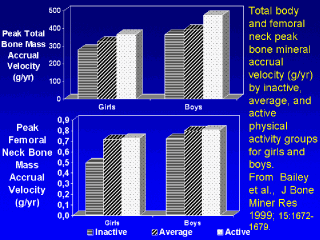 |
In what
may be the strongest observational study to date, Bailey and colleagues conducted a
six-year follow-up in 103 boys and girls (mean age 14 years at baseline) (10). Habitual
physical activity was assessed every 6 months using a questionnaire and bone measures were
assessed annually using DXA. This approach allowed the investigators to fit distance and
velocity curves for bone mass and calculate age at peak bone mass. Active boys had a 9%
greater and active girls had a 17% greater total body peak bone mass than inactive peers.
For the femoral neck, this difference was 7% and 11% higher for active boys and girls,
respectively, as compared with inactive peers. Physical activity’s impact on bone
accrual was consistent and statistically significant across all bone sites for boys and
girls. For example, the magnitude of total bone mass accrual at peak was 409 g/year for
active compared to 331 g/year for inactive subjects. This longitudinal study appears to
substantiate the results of earlier cross-sectional studies. 10. Bailey DA, McKay HA, Mirwald RL, Crocker PRE, Faulkner RA. A
six-year longitudinal study of the relationship of physical activity to bone mineral
accrual in growing children: The University of Saskatchewan Bone Mineral Accrual Study. J
Bone Miner Res 1999;14:1672-1679. |
